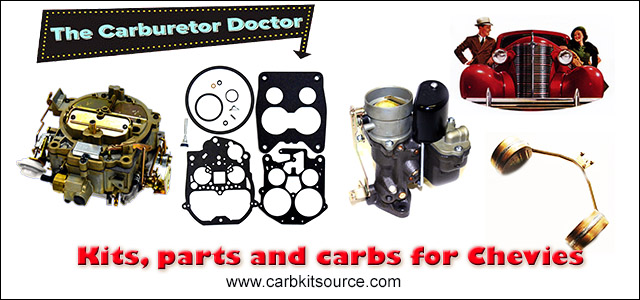Automotive Carburetion Made Easy
UM-900 (1952)
|
|
||||||
|
BASIC CARBURETION Continued
The automotive carburetor, although relatively inexpensive and easy
to service, is expected to meet
many demands of the car owner, such as:
1.
Maximum Power
4. Smooth
operation regardless of
2.
Economical
Operation
throttle maneuvers
or weather conditions
3.
Flexibility (e.g.
altitude) 5. Rapid Acceleration
|
||||||
|
|
||||||
 |
O" HG VACUUM NO VELOCITY
|
|||||
 |
When the engine piston moves
down, it creates suction in the intake
manifold. Assuming that there is
suction at the bottom of
this pipe and atmospheric
pressure at the top, air
will flow through. As shown in the mercury U-tubes, the greatest suction
is at the point of smallest area
or highest velocity (C). Note in
(E) that if the tube
points into the air stream it merely transmits the pressure
in the pipe to the mercury in
the U-tube. We use these
principles to draw fuel
from a carburetor.
|
|||||
|
1" HO VACUUM LOW
VELOCITY LAROE AREA
|
||||||
|
1" HO VACUUM HIGH
VELOCITY SMALL AREA
|
||||||
|
2" HO VACUUM MODERATE
VELOCITY MODERATE
AREA
|
||||||
|
|
||||||
|
This is a simple
single jet carbure-tor. The float mechanism maintains the fuel level
in the carburetor bowl. We know that by placing one venturi inside
another we can increase suction (F,G). The main discharge nozzle is
located at the smallest area or point of greatest suction. As the
piston speed increases and suction
increases, fuel is drawn from the float bowl up through the
main dis-charge nozzle and enters
the main air stream. When the piston stops there is no suction
and the fuel level drops below the
tip of the nozzle, thus preventing leakage. Note that the
balance tube faces directly into
the air stream, and so transmits pressure to the fuel in the
float bowl.
|
 |
 |
||||
|
The difference in
pressure between the balance tube and main discharge nozzle causes
fuel flow.
|
||||||
|
|
||||||
|
5
|
||||||
|
|
||||||
